April 19 - 25, 2015: Issue 210
Royal Visits to Australia
Jane Connors Celebration
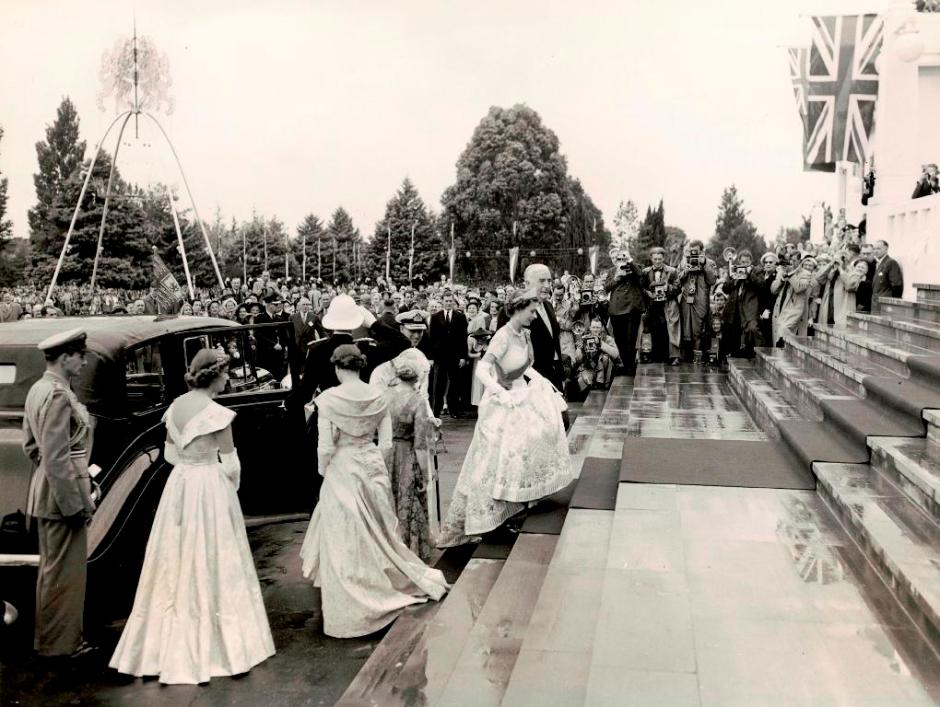
Page 93: Australian News and Information Bureau - Her Majesty arrives at Parliament House..escorted by the Prime Minister, Mr. R G Menzies...to Open the Third Session of the 20th Federal Parliament on February 15, 1954. b&w photograph, Pictures Collection nla.gov.au/nla-pic.vn3580181
Royal Visits to Australia
A New Book from National Library of Australia - by Jane Connors
Pittwater has many connections with the British Royal Family; the Royal Prince Alfred Yacht Club was named for the first member of the Royal family to visit Australia, Prince Alfred, when the club members still sailed on Sydney Harbour and to Pittwater. His ‘picnic’ at Clontarf to support the Sailors Home, an assassination attempt by a very recent arrival, and the outrage of citizens afterwards, begins a long and enduring romance with and for succeeding generations of our Royal family.
The second Royal visitors to our shores, Princes Albert and George, came here too in 1883 for a visit, boarding a steamer at Newport Wharf for a tour along the Hawkesbury River. They travelled overland in a coach they boarded at Manly – their relative’s experience not deterring a chance to see the beauty of this place.
In 1901 the Duke and Duchess of Cornwall also spent a restful time on the Hawkesbury, mooring adjacent to our estuary, after their official duties in opening the first Parliament of Australia in the year of our Federation.
Some residents recall being a part of Queen Elizabeth’s first visit as Naval Cadets, while Palm Beach SLSC founding member and ‘the Father of Surf Life Saving’, Adrian Curlewis, along with his wife Betty Curlewis, were gracious hosts of Queen Elizabeth II and the Duke of Edinburgh at the Bondi Royal Surf Carnival of 1954. Many still remember Her Majesty’s later visit to Manly, to the Royal Far West Children’s home in 1970 or her mother's salute of a 1958 Life Saving Carnival for her benefit at Manly too.
During the 1954 Royal Tour Her Majesty’s ladies-in-waiting caused some to think the Queen was water skiing on Narrabeen Lagoon or lunching at Palm Beach until who was whom was clarified. Some are still certain Queen Elizabeth did have a few days off at Palm Beach which reports from that year can neither confirm nor deny:
Ladies-in-waiting Confuse Crowds
Cars containing the Queen's Ladies in-Waiting confused crowds yesterday who rushed to see the Queen pass. The people thought the Queen would be in the cars. The Ladies-in-Waiting are Lady Pamela Mountbatten and Lady Alice Egerton. Both went driving-Lady Pamela to Narrabeen Lake to water-ski, and Lady Alice to Palm Beach.
Hundreds thought Lady Pamela was the. Queen when they saw her driving to Narrabeen Lake. She drove to the lake in a Royal tour Daimler. Two men went with her to the lake, and also Miss Elizabeth Northcott, daughter of the Governor of N.S.W., Sir John Northcott.
ARMY DRIVERS
The party used two cars driven by Army personnel. Crowds rushed to the road-side, waving flags and cheering when they saw the two cars approaching. Both cars were black and both bore silver crowns. About 150 people were waiting outside Dalwood Homes, in Wakehurst Park-way in case the Queen passed. They groaned with disappointment when they saw that neither the Queen nor the Duke of Edinburgh was in the cars.
Groups of people further along the road caught only a glimpse of the occupants, and thought they had seen the Queen. When told they had not seen the Queen they decided to wait in case she also passed. Mr. W. Ledsan, president of the Dolphin Water Ski Club, met the party at the lake.
Lady Mountbatten then changed from a light cotton print frock into a white swimming costume and she and Miss Northcott climbed into a motor boat. Mr. Ledsan drove the motorboat to the end of the lake, where the water was calm. Half an hour later the boat returned towing Lady Pamela on water-skis.
Water-ski experts, among a crowd of 200 who watched, said Lady Pamela was a proficient water-skier. She was on the lake for nearly an hour.
PALM BEACH TRIP
Lady Alice Egerton, meanwhile, was in a party of two Royal cars that went to Palm Beach. With her were the Queens secretary, Sir Michael Ademe, her assistant secretary, Colonel Martin Charteris, the Minister in charge of the Royal tour, Mr. Eric Harrison, and the Commonwealth Director, Lieutenant-Colonel F. H. Berryman.
Crowds cheered, waved, and tooted motor horns as the cars passed them on the way to Palm Beach. When they saw the Queen was not in the cars they also decided to wait for the Queen. A rumour spread that the Queen's car would come next.
At Palm Beach the party went to the home of Mr. Sam Walder. All the party surfed later except Lady Alice, who sat on the beach. Mr. Walder's home is near the home of Mr. J. Carroll, where it was rumoured last week that the Queen and Duke would rest. Ladies-in-waiting Confuse Crowds. (1954, February 8). The Sydney Morning Herald (NSW : 1842 - 1954), p. 4. Retrieved from http://nla.gov.au/nla.news-article18408639
Other officials attending the Royal Family have also taken part in Pittwater times either informally or formally – a lovely example resounds from October 5th 1958, when Admiral H.J. Buchanan, C.B.E./D.S.O., aide-de-camp to both King George VI and Queen Elizabeth II, officially opened the Avalon Sailing Club.
Brian Friend OAM, related being privileged in his days as a member of the Water Police of Pittwater to be part of the crew that gained a day off for, and a visit to where so many relatives had been before them, in showing Prince Charles and Lady Diana around our superlative estuary and her waters.
More recently Prince Harry was part of the International Fleet Review salute at Bradley’s Head, within cooee of the Northern Beaches, while Prince William and Duchess of Cambridge, Kate, made sure Manly and a Surf Life Saving Carnival was part of their first tour here together.
Many Royal family members have served as members of the Royal Navy, so visiting Pittwater or other places on the Northern Beaches would allow them an insight or a day off in an environment they love as well as getting to experience eponymous Australian events and lifestyle. The affection remains mutual in a place that welcomes all and celebrates what is known locally as ‘democracy on the sand and water’.
A new book, launched this month from records held by Australia’s National Library, celebrates these many visits and some of their quirkier moments. Filled with glorious images and photographs, Royal Visits to Australia catalogues our love for, fascination with and natural honouring of that continual raised standard any human being worth their salt salutes and helps to perpetuate.
We recently asked author Jane Connors a few questions about this work:
Australians love the Royal Family of Britain and have a fascination with learning about the cultures of other places through other visiting Royal families – to what would you attribute this continuing popularity?
For so much of our history since settlement in 1789, the British Royal Family have been a very human symbol of connection between Australia and the ‘old country’. And especially since the advent of mass media in the 19th century, Australians have grown up surrounded by pictures and stories of each generation of the Royal Family. Other celebrities rise and fall, but the Royal Family goes on forever.
Similarly, the Royal families of other nations are an easy and visible way of gaining an impression of another culture.
We’re a hard-working Nation, blue-collar to white-collar, and yet all paused to watch Her Majesty Queen Elizabeth during her first visit ( 7 million out of a population 9 million turning out to see her) – and thousands turned out to see Prince Harry and the Duchess of Cambridge in their most recent visit - does this reflect our desire to keep our eyes on something we value or an awareness that even if we're farmers, with a 'noble' connection to the soil, we are crowned by a loftier heritage?
Before the arrival of television, the only way to see a member of the Royal Family was to head out on to the streets for a real-life glimpse. Since television, the crowds have become smaller (but still bigger than for most other popular events). But even today, people in the crowds for a royal tour say they come along because of that sense of history about the Royal family. Many people, even if they aren’t particularly monarchist – and even some republicans – still have the feeling that they should see at least one royal in their lifetime.
In almost every royal tour, there has been a lot of talk about the ‘real’ Australia, and it’s almost always been agreed that the ‘real’ Australia is in the bush and the regional towns. The Royal Family themselves have usually seemed to prefer time away from the big cities, even if that is where the crowds are. And during the early visits in particular, we were keen to show the royal travellers all the things which are unique about Australia. British journalists were always keen to write about or photograph the things they found exotic, like the flora and fauna and the rural and remote landscapes so they were always a big feature.
The failed assassination attempt at Clontarf in 1867 – why is this among your favourites?
Well, it’s just such a dramatic story, but also quite funny now after all these years. Especially the idea that you could be saved from a bullet by the thickness of your braces! The agonies of remorse from all around the country were fascinating, and I think it also influenced a sense that Australians were ‘rough colonials’ for the next century – some Australians embraced that title, but many were ashamed.
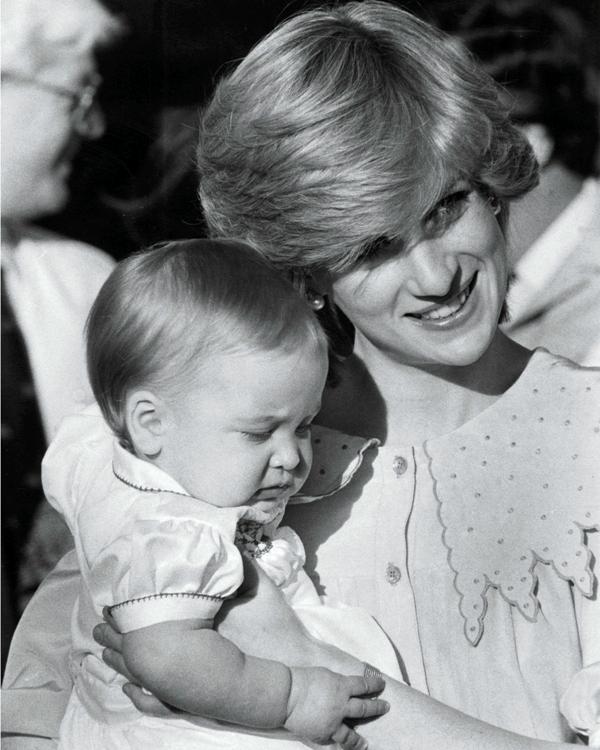 From a Pittwater-Northern Beaches perspective, all Royal Visits to Australia have included an ‘excursion’ to our area – sometimes as ‘meet and greets’ and often as ‘time-out’ excursions for rest and pleasure – what would you ascribe this to; a long Naval history of the British Isles or being able to be in a place that also has a historic aquatic and still current sailing and environmental beauty?
From a Pittwater-Northern Beaches perspective, all Royal Visits to Australia have included an ‘excursion’ to our area – sometimes as ‘meet and greets’ and often as ‘time-out’ excursions for rest and pleasure – what would you ascribe this to; a long Naval history of the British Isles or being able to be in a place that also has a historic aquatic and still current sailing and environmental beauty?
I think both are right, although the naval aspects have probably faded as the world wars have receded into history, and it’s the beautiful beaches that draw the royal tourists in now.
Right; Page 179: Bruce Howard (b. 1936) - In the Sunshine of a Sunday in March 1983 Princess Diana Holds Baby Prince William at Alice Springs Airport 1983 B&w photograph. Pictures Collection nla.gov.au pic vn3061365
If you had a time machine, and a position on the staff of either the British or Australian contingents for all tours – what position would you have and which tour would you choose to be a part of and why?
That’s a hard one. Goodness. I think I would have liked to be a lady-in-waiting in 1954. I would love to know what the Queen and Duke really thought about Australia and all the astounding fuss and noise on the streets.You’d also get a birdseye view on all the politics within the touring party and the government, and after all that, you’d get to play with the jewels.
Please share three examples of three Royal Tours which, in your opinion, mark and example our maturation as a nation with our continued willingness to have and keep a Royal Head of State:
The Tour of 1901 was interesting in this regard, because the Duke and Duchess of Cornwall and York (later Geroge V and Queen Mary) came out for the ceremonies to establish Australia as a nation. The more radical newspapers complained that the presence of a royal prince undermined the whole value of Federation and were outraged that the crowds on the streets seemed more interested in the royals than in this milestone on the road to independence.
Other tours with signficant constitutional interest included 1977 (the first visit after the Dismissal), and 2000 (the first visit after the failed referendum on the republic). On each occasion, widespread public protest was anticipated but largely failed to occur.
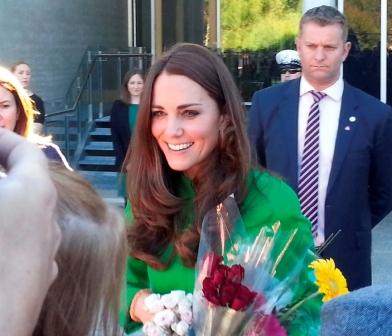 The 1983 tour of Diana and the most recent by William and Kate, as well as our welcome for Prince Harry in his current visit here; these royal family members show a contemporary shift, a dynamic aspect of a centuries old family – what stands out for you most about these generations and why they appeal to Australians?
The 1983 tour of Diana and the most recent by William and Kate, as well as our welcome for Prince Harry in his current visit here; these royal family members show a contemporary shift, a dynamic aspect of a centuries old family – what stands out for you most about these generations and why they appeal to Australians?
During and after the time of Diana, I think it is clear that royalty and celebrity have merged closer and closer together, and it’s a bit more difficult to see what is special about royalty. But I still think there is something significant in their connection to history (and the ‘mists of time’) that many Australians still respond to. There is still great interest in the idea that their lives are ordinary in some ways (they have babies and they get divorced the same way we do) but also bizarre because they really do live in palaces and are on permanent display.
Right: Page 198: Jemma Posch - Catherine, Duchess of Cambridge, Greeting Wellwishers at the National Portrait Gallery, Canberra, Australia, 24 April, 2014 - digital photograph courtesy Jemma Posch
Your interest in the Royal Family informs and contributes to other's knowledge of this part of our culture – can you point to the spark that began what has coaleseced into this wonderful book?
In the very early 1970s, the ABC played two fabulous series from the BBC – The Six Wives of Henry VIII and Elizabeth R, with Glenda Jackson. I was only 8 or 9, but my parents let me stay up late to watch them and they sparked a lifelong interest in history, and history telling, and about how central Royalty was to how we understood English history (which was still a very big part of the curriculum in schools in those days).
Later on, we had the whole Diana phenomenon (I wore a big badge saying ‘Don’t do it, Di’, but I still sat up late to watch the wedding) and I became very interested in why it was all still so interesting.
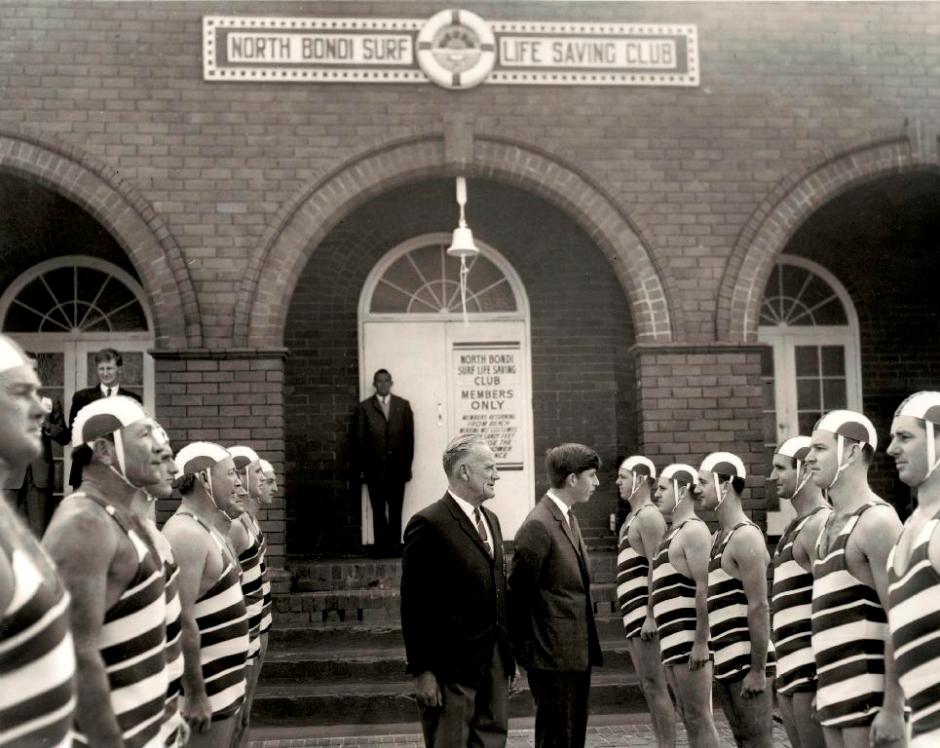
Page 165: Ern McQuallan (b. 1926) Prince Charles at the North Bondi Surf Club, with Club President Charlies Christenson (and Life Savers), 25 May 1966. B7w photograph. Pictures Collection -nla.gov.au/nla.pic-vn3562116
Royal Visits to Australia
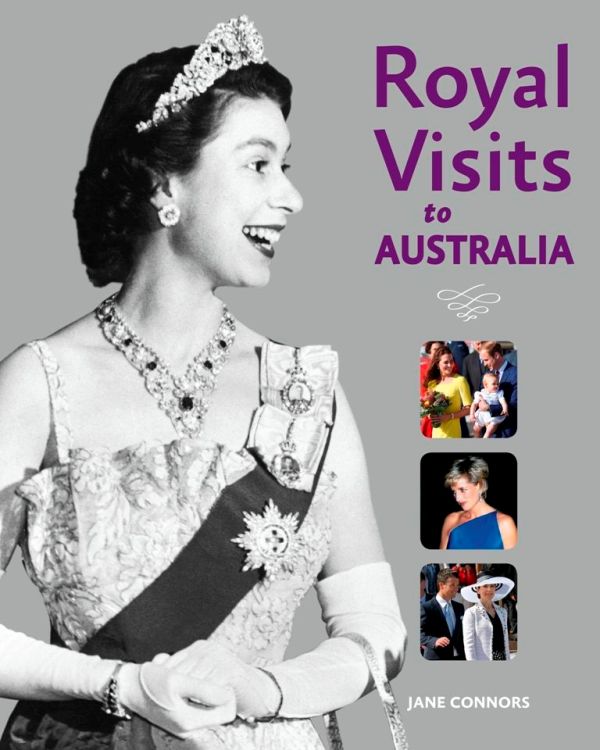 Author: Jane Connors
Author: Jane Connors
Publisher: National Library of Australia
Edition: 1st Edition . ISBN: 9780642278708. Pages: 232. Publication Date: 01 April 2015
Price $39.99 Purchase Online or at any good bookshop
Out of Australia’s total population of around nine million, an estimated seven million people turned out to catch a glimpse of the newly crowned Queen Elizabeth II in 1954.
Sixty years later, in April 2014, television news bulletins, newspapers and social media were awash with stories of the royal visit of Prince William, his wife Catherine and their baby son George.
The frequent, whirlwind royal tours of today are a far cry from those to Australia between 1867 and 1954. These stretched over months, bursting with events such as civic receptions, state banquets, military reviews, cricket matches, agricultural shows, processions, schoolchildren’s pageants and the laying of foundation stones. Occasionally shambolic, quarrelsome and raucous affairs, they were always intensely patriotic.
While most of the visits described in this book are from the British Royal Family, royals from other countries appear too, including ‘Our Mary’ of the Danish Royal Family, proudly claimed by Australians as their own.
Royal Visits to Australia provides a fascinating glimpse into the evolving Australian psyche and cultural identity. Although our enthusiasm for the Royal Family has waxed and waned over the decades, it is tempting to attribute the fervour of today’s young people to modern celebrity culture. Royal Visits to Australia uncovers an affection that runs much deeper than a passing crush.
The book is richly illustrated with stunning full page and double-page black-and-white photos from the early years to magnificent colour photos of more recent years. Also included is a vast array of drawings, lithographs, illuminated addresses, magazine articles, programs, menus and invitation cards and other souvenirs.
Royal Visits to Australia is packed with fascinating stories and firsthand accounts. Read about an assassination attempt on Prince Alfred, the first royal visitor, in 1867; the weeping and hysteria of hundreds of thousands of people at Fremantle at the departure of the Duke and Duchess of Cornwall and York, in 1901; the unprecedented scenes of wild welcome at the 1954 visit of Queen Elizabeth II, the first reigning monarch to visit Australia; allegations of the Irish Republican Army (IRA) attempting to assassinate Prince Philip in Sydney in 1973; media obsession with discerning romantic gestures and stories of cracks in the marriage of Prince Charles and Princess Diana, in the 1980s; and, in 2014, William and Kate’s visit, with baby George in tow, the first royal tour since the social media revolution.
Jane Connors’ interest in the royals was sparked when she was studying for her three degrees in history and public history (including a PhD on the Royal Tour of 1954). After a long apprenticeship at Community Radio station 2XX in Canberra, Jane joined the ABC as an intern in 1989 and later became the Executive Producer of the Social History Unit at Radio National. She was the Manager of Radio National for six years and is now a senior policy advisor within the Radio Division.
Jane lives in Sydney with her partner and their son. She drank far too much champagne at a garden reception for the Prince and Princess of Wales at Parliament House in 1983 and has been trying to atone for it ever since.
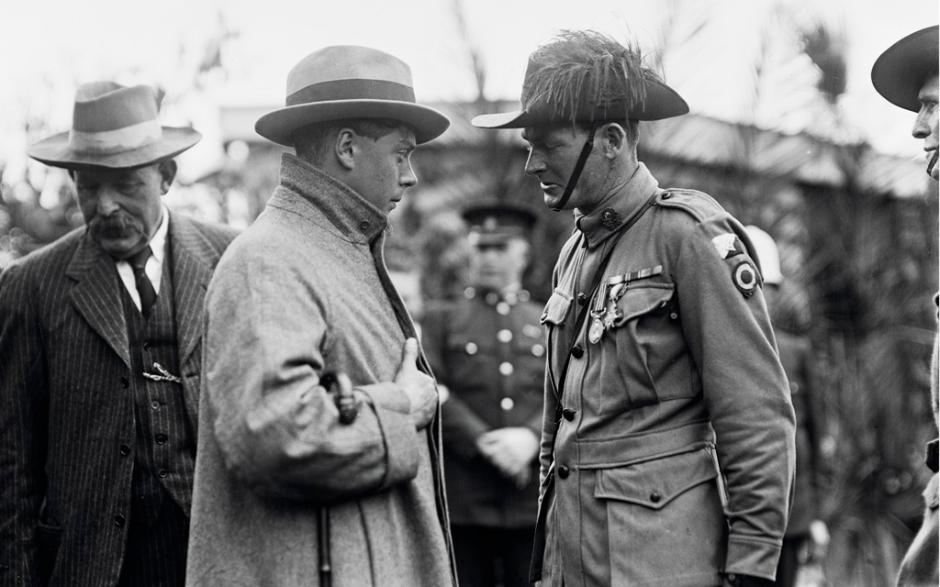
Page 50-51: Edward, the Prince of Wales, speaks to a Soldier in Queensland during his Visit to Australia in 1920.
THE PRINCE OF WALES - A MILITARY PARADE. Sydney, June 22.
This afternoon the Prince was present at a military parade at the Centennial Park. The Prince, who had been cheered all the way from town, received a tumultuous welcome from toe thousands pre- .sent. As be came on to the parade his glance wandered to the two stands containing wounded men and relatives of the fallen. When he surveyed the dense mass of khaki he was visibly moved. After passing down the lines the Prince took his stand at the saluting base, and the assembled troops, forming into columns, continued towards the Oxford-street gate of the park, and reaching them halted, and divided on either side of the roadway, to form a long cheering double rank through which the Prince passed.
On his way back to town the Prince 'spoke in n number of officers and men, many of whom he had seen in France or Belgium, and some of whom he readily recognised. The whole ceremonial was impressive. There were representatives of every unit that left Sydney for the war, besides many other formations, such as Imperial troops, South African, and Soudan contingents.
The Prince was welcomed in Sydney today by representatives of 200 branches throughout the State of the Returned Soldiers' Association at a luncheon at the Town Hall. The president (Lieutenant E. F. McDonald) read an address, to which the Prince replied. In an adjoining room, 56 blinded soldiers and their escorts also sat down to lunch. His Highness shook hands with every one of them. The Prince said, "I may claim to say that this is only, au revoir and not good-bye. I am coming back in August, and I have arranged with the president of your association that the returned men shall have a day to visit the Renown and go all over the ship. ;'(Loud cheers.)
THE PRINCE OF WALES. (1920, June 23). The Advertiser(Adelaide, SA : 1889 - 1931), p. 7. Retrieved from http://nla.gov.au/nla.news-article37521969
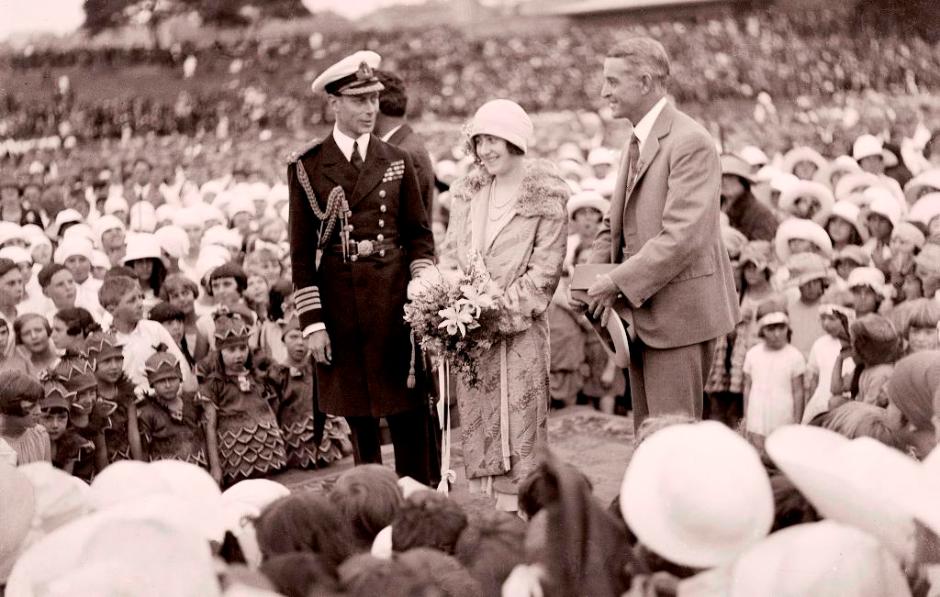
Page 54: Duke and Duchess of York Addressing Crowds in Sydney during their Royal Tour, 29 March, 1927
A LIVING ROSE OF WELCOME. Formed by 10,000 Children. DISPLAY AT THE CRICKET GROUND.
A white rose, panting with the joy of the 10,000 children who were its trembling petals, bloomed on the Cricket Ground yesterday about the Duke and Duchess of York-bloomed, quivered, an instant, then, in a gale of delight, shattered its leaves over its scarlet heart. That was the climax of the display with which the children of the metropolitan Public schools lavished their enthusiasm, feverish and abandoned on the visitors. It was a tremendous moment, when the whole place vibrated with that riotously frank affection which only the very young, the very happy, and the deeply fascinated can offer. Lord Cavan blanched, his Excellency the Governor looked as though he had abandoned hope, the pressmen almost stampeded. And for one moment it really did seem that this yelling, crushed, swaying ocean of superlatively overjoyed school children would foam, in an indomitable wave, up to the dais, trample down the phalanx of protecting adults, and carry off the Duchess for themselves.
The Duke did not seem particularly certain of himself, and there was a sense of the situation's possibilities in the glance he turned to-wards the Minister for Education (Mr. Mutch),his escort.
"How on earth are we going to get out of this?" ho said.
"Oh, you don't know an Australian crowd," said Mr. Mutch. "They'll let you out."
And they did, but reluctantly. Since they arrived in Sydney the Duke and the Duchess have not been so wildly, so candidly worshipped as they were in the moments they spent in the heart of that rose. They will sleep for many nights with the echo of that endless scream of joy; it will ring in their ears when-ever they see a child. It is improbable, in-deed, that they will ever face s0 terrifying and overwhelming a cataract of noise again.
A LONG WAIT.
The huge impatient assembly of children had screwed their nerves to that moment through weeks of anticipation, through the last long, anxious wait which crowded streets forced the Royal party to impose upon them. After the luncheon at the Wentworth the Duke drove to Government House through a crowd not very much less demonstrative or enormous than that which welcomed him on Saturday morning. So he was a few minutes behind his programme when be left for the Cricket Ground with the Duchess, who was still smiling and fresh under a blue hat that really did deserve a properly clear autumn sky and a touch of gold sunlight to prick out its colour.
"Does anybody work in Sydney?” the Duke wants to know. He drove through thousands of people from the Wentworth, and 200,000 or 300,000 must have lined the streets along which he passed to the Cricket Ground. The cars jerked along, wasting precious minutes in the very important endeavour to avoid mowing down the more inordinately curious who hung from motor and tram cars, evaded policemen, and flung out their hands to consecrate their fingers against the paint of the Royal car.
Meanwhile 10,000 children shivered. The wind gasped across the oval, stinging unclad legs and little bodies arrayed in films of silk for Eurythmics and country dances. Very small children commenced to express their impatience. They cried.
"We want the Duke. Where's the Duke, teacher? Isn't the Duke coming?"
He was doing his best, but near the Cricket Ground his chauffeur shuddered at the sight of a black, fearless wall of curious people, who were willing to be run over rather than miss a glimpse of the Duke and his Duchess, apparently.
A roar that ran down the avenues leading to the Cricket Ground like a flame leaping from group to group echoed into the oval and broke the silence there. Through the 25 minutes that had passed since the moment at which the Duke was expected a heavy, sullen, murmurous quietness had fallen on the place, the quietness of children disappointed at the burning crest of their enthusiasm and delight, the silence of children promised a gorgeous present, nurtured through weeks of expectation, and at the last second denied. But those early moments of clouded joy perfected the experience, for now the Duke and the Duchess burst in upon them suddenly. Almost, with the ready pessimism of child-hood, they had ceased to hope that he would come at all, had abandoned themselves to the cold and the comparatively empty task of performing their evolutions for the 45,000 people in the stands who were not Dukes and Duchess of York. But youth is capable also of quick recoveries, and when their Royal Highnesses, smiling a contrite smile now, hurried on to the ground, tears had evaporated frowns were washed out in smiles, and an explosion of very thrilling joy swept disappointment from every heart.
A GARDEN IN A GALE.
At this moment the oval looked like a neglected garden In a gale. Little bluebells were tossed about among bunches of scarlet, fading orchids, and across the lawn struggled a few hundred incredibly scarlet poppies. The children were forming themselves together for a folk dance, a delicate affair of lightly interlaced fingers and diaphanous, wind-whipped skirts. A thousand little girls never faltered, never moved one moment too soon, never did anything which betrayed that they had practised these intricate movements only for a few weeks.
And here one commenced to realise the triumph of this organisation. One thousand little girls had yearned through months for this moment, dreamed of it, talked their mothers to exasperation about it. But not one there hesitated in the dance to indulge a heart that must have been yearning to seethe Duchess for whom everyone was enormously cheering.
Mr. Mutch was overwhelmed by dignity and confusion, but he led the Duchess through another insatiably curious crowd to the principal stand, where she watched the dances and, at last, the blooming of the rose. Fairies swept out from the wrings, flowers rose and walked, Neptune appeared with his arm round the waist of a very dignified Elizabethan lady, pirates swarmed over the grounds glittering their arms and turning most unferocious eyes towards the Royal stand, girl guides, cowboys, sundowners, sea scouts, colleens, numerous Britannias, burst out upon the oval suddenly, and were swept into that huge, opening flower.
Meanwhile twelve other roses, buttonholes, blossomed about the fringe of the grounds, and one suppressed a shudder and a little superstitious dread of this thirteen. The number was symbolic, for as far the the organisers of the display could discover Prince Albert is the thirteenth Duke of York. What with the wars of the Roses and other troubles, however, the point is very indefinite.
The word "Welcome" wrote itself across the ground. Rapidly the flowers expanded, and to see the great rose in its full, bursting glory the Royal party left the lower stand
and climbed to higher seats which overlooked the grounds. The children, ready to fear the worst, sighed an audibly touching sigh, as the Duchess's blue hat sank into the maelstrom of crowding people around the gate, and when she appeared again, high above them, they offered her a cheer that was not on their programme. Shrill voices over all the ground caught up the cry, and the Renown Band, playing at a delicate pianissimo, was obliterated and confused. Indignantly it packed up its music, and joined forces with the New South Wales Fire Brigade Band. That allowed some of the children's bands to slip in a piece or two, delighting the Duchess tremendously; so tremendously, in fact that when she was telling Mr. Mutch how happy the children had made her, she spoke specially of the boys who "adored her over the tops of the trombones on which they played Scottish airs.
The cheering died back into a silence that was heavy with expectation, and suddenly the rose, complete now, fluttered to life. Rank by rank those ten thousand children waved red and yellow flags, so that the colour seemed to rise up in waves, like a perfume become perceptible. The silence endured for another second, then everyone in the place commenced to sing "Australia Fair." This was a signal, and the Royal party rose, and, descending to the oval, walked down a narrow lane of trembling petals to the dais that was the heart of the flower. These wore the high moments of the afternoon. The children cheered one long, tremendous cheer, that seemed never to end. The Duchess smiled over them all, inspiring new enthusiasm, strengthening their lungs, lighting their hushed faces to a more crimson betrayal of their Joy.
"GENTLE LADY."
Then, as they paused one second for breath, the band caught up their voices into a song of welcome specially composed for this day byMessrs E. Webster (Cleveland-street Inter-mediate High School), and F. Treharne (superintendent of music). The Duchess, very obviously touched, looked down into a cloud of bright faces, whose parted lips told her
Gentle Lady, thee we greet,
Not by wealth and power complete,
Rather for thy nature sweet,
Welcome to Australia!
As a wife at love's behest,
Mother, too, most richly blest,
Thou art woman at her best,
Welcome to Australia!
Then came the great moment of childish ebullience, and when the Duchess had almost escaped from that forest of adoring faces, two little girls asked her: "Can't we have a holiday, Duchess?"
The Duchess raised inquiring and rather indignant eyebrows to Mr. Mutch, who stammered "Of course, of course." An official of the department suggested a day, but the Duchess pouted and remarked: "Oh, that’s not very much." Someone else agreed, and remembered that the Prince had gained a
week for the children. The Duchess turned then to the Duke and said, "Well, we mustn’t let your brother beat us, must we?" So a week everyone agreed it should be, and when the scoreboard announced this, young lungs almost burst themselves in indescribable yells of praise for a gracious and generous lady.
The Duke and Duchess complimented Mr. Mutch on the display, and received Messrs. V. Gordon (secretary of the Primary Schools Amateur Athletic Association), A. S. Garden(chairman), and Mr. W. J. Cunningham (vice president). Other officers of the department present included Messrs. S. Lasker (acting Director of Education), B. C. Harkness (assist-ant director), and W. Elliott (Chief Inspector of High Schools).
Photo: CHILDREN'S PRESENTATION OF A BOUQUET TO THE DUCHESS. A LIVING ROSE OF WELCOME. (1927, March 30). The Sydney Morning Herald (NSW : 1842 - 1954), p. 16. Retrieved from http://nla.gov.au/nla.news-article16384049
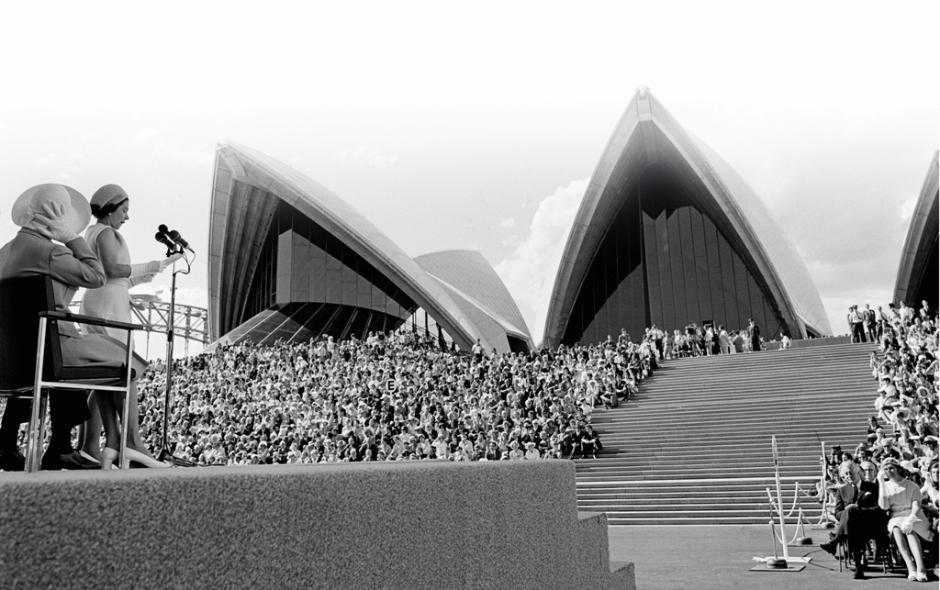
Page 170-171: Australian Information Service - Royalty - Queen and Royal Family - The Queen in Sydney for an Opening at the Opera House, New South Wales, New South Wales, 1973. b&w photograph - National Archives of Australia NAA A61801/11/73/49 Courtesy National Archives of Australia.